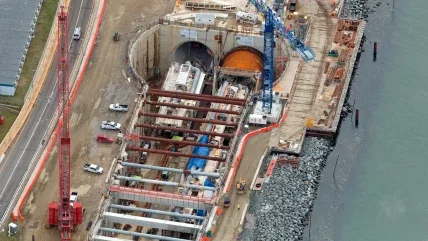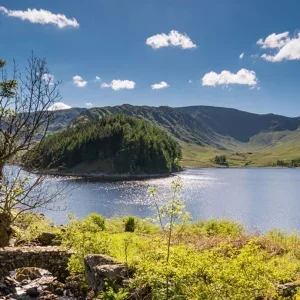
TBM Mary is tunnelling back towards South Island after breaking through at the North Island reception pit, completing the first bore – and Virginia’s first bored road tunnel – in April.
After completing the first 2.41km tunnel TBM Mary underwent extensive maintenance to ensure efficient effective operation on the return trip to South Island.
HRBT Expansion project director Ryan Banas said the TBM cutting tools were inspected and replaced as necessary, all parts cleaned, and proper operation verified, and a detailed commissioning and testing procedure ensured the operation of the TBM and the safety of the crew operating it.
Nitrogen skates were used to rotate the variable density TBM for the return journey.
The first tunnel was excavated in 51 weeks and Banas expected that the experience gained would enable the second tunnel to be completed more quickly.

“Many lessons were learned during the first bore, but the most significant is how to operate the TBM slurry treatment plant, and all the logistics around both, such as muck disposal, segment delivery, consumable supply, operation of bicomponent plant, operation of water treatment plant, in harmony to maximise production and minimise downtime and quality issues,” Banas told T&TI.
“Furthermore, the team has nearly one year of experience operating the TBM under their belt. This boots-on-the-ground experience allows them to appreciate the tendencies of the machine and how it will likely behave in specific ground conditions.”
The ground conditions for the second tunnel are considered “soft” by geotechnical standards. The geology of the alignment mainly comprises alluvial fine-grained and coarse-grained sands with some areas of plastic and organic soils. Underneath the two islands are artificial fill and zones of ground improvement.
Banas said the challenge of boring subaqueous tunnels in soft soils was added to by the sheer weight and size of the TBM.
“At 4,700 US tons with a 46ft (14m) diameter, TBM Mary is well matched for the task of excavating Virginia’s first ever bored tunnel for vehicular traffic. Coupled with an offshore marine environment for launch and receiving pits, the necessity for just-in-time logistics, and the weather restrictions faced by supporting cranes and barges, there are many challenges associated with expanding the HRBT,” he said.
The challenges of the two tunnels were very similar, he added, but the second tunnel’s supply of slurry and segments required even greater co-ordination as both items would continue to be supplied from South Island.
“This means slurry and segments will travel up to three miles underground prior to being incorporated into the tunnel just prior to the TBM’s arrival on South Island,” said Banas.
The interior of each tunnel includes an emergency egress corridor which is separated from the road.
The US$3.9bn HRBT is the largest highway construction project in Virginia’s history. The project aims to ease congestion along a 16km corridor on the I-64 through the addition of twin, two-lane bored tunnels under the harbour from Hampton to Norfolk and the widening of four-lane segments.
It is being built by Hampton Roads Connector Partners (HRCP), a consortium of Dragados USA, Vinci, Flatiron Constructors, and Dodin Campenon Bernard.







